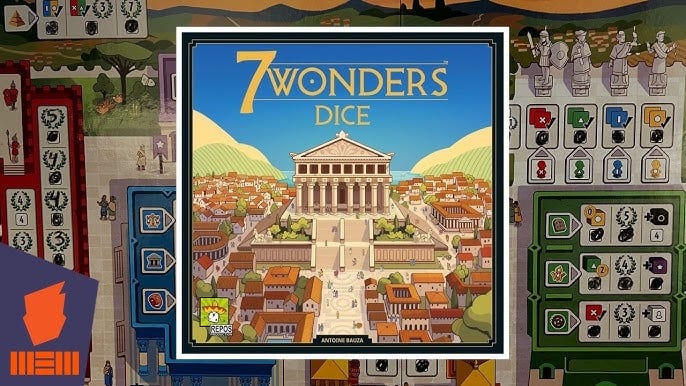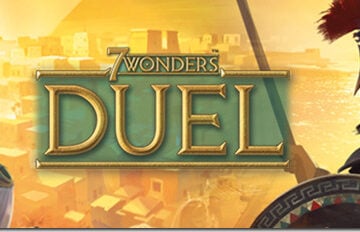7 Wonders Dice out now!

In the world of modern board-gaming, few franchises carry as much weight as 7 Wonders. Released originally in 2010 and designed by Antoine Bauza, it lets players take the helm of one of the famed ancient cities, build a Wonder, develop science, commerce, military, and vie for glory. Now comes a fresh twist: 7 Wonders Dice, a roll-and-write (or shake-and-write) reinterpretation of that legacy: stripped down, fast-paced, tactile, yet steeped in the same ancient world theme.
What is 7 Wonders Dice?
The core idea is deceptively simple: you lead one of the seven greatest cities of antiquity. You’ll build your city’s Wonder, advance scientifically, foster trade, manage resources and gold — all while staying alert to what your neighbours (other players) are doing. According to the product description, the game includes high-quality dice, seven “Wonder trays” (one per city), erasable pencils and wipes, a scoreboard, and game-aids.
Mechanically, instead of the card-drafting of the original game, you have a central “Forum” or dice-market: dice are shaken (revealing faces) in a communal box, then players simultaneously pick dice and mark on their personal city sheet what results they’ve achieved. The game supports up to 7 players, plays in roughly 20-30 minutes, and is pitched as accessible while retaining strategic depth.
By adopting the dice mechanic and a faster tempo, the design offers a lighter yet thematically connected experience to the original. It becomes an excellent gateway for players who found the original’s drafting engine rich but somewhat heavier, or for mixed groups seeking a more casual-yet-meaningful game session.
Gameplay highlights
Here are some of the standout mechanics, and how they reshape the wonder-building experience:
- Simultaneous play, minimal downtime: All players pick their dice at the same time rather than waiting on turns. This mirrors one of the strengths of the original game (which also minimized downtime) and translates well to a more social, fast-moving game.
- Dice as building blocks: Rather than playing cards representing buildings, you’re selecting dice whose faces represent resources, technologies, trade gains, or special actions. This gives a tactile, visual feel: you shake, reveal, choose.
- Wonder boards with asymmetric powers: Each of the seven city boards has its own unique Wonder and special unlocks, meaning that choosing which city you lead matters more than simply picking a board colour. Flavor and mechanical variety converge.
- Classic paths of development: Although the medium changes, the pillars remain: science, commerce/trade, culture/civic, resources/military. These were the hallmarks of the original 7 Wonders’ design.
- Strategic choices in a short time-frame: Because the game is designed for roughly 25–30 minutes, the decisions must be sharp: do you grab a dice face for immediate payoff? Invest for your Wonder stage? Block a neighbour?
- Replayability through variety and combination: With seven different Wonders, multiple strategies (go science-heavy, trade-heavy, wonder-rush) and random dice sets, the game promises a lot of replay value for relatively little time investment. The erasable sheets add practical replay support.
The classical and mythological theme: why it matters
What elevates 7 Wonders Dice above a generic dice-game is its rich thematic anchor: you’re still in the world of the “Seven Wonders of the Ancient World” — the legendary monuments that have fascinated historians, mythographers and modern gamers alike. Several of those Wonders are intimately tied to Greek mythology or Hellenistic history, which gives the game a deeper cultural resonance.
When you launch into your city’s Wonder, you are (implicitly) following in the footsteps of ancient builders: sculptors creating chryselephantine cult images, architects raising massive columns, civic councils commissioning grand temples. The game doesn’t ask you to be a historian, but the flavour works: the wonders alluded to (for instance the Temple of Artemis, the Statue of Zeus at Olympia, the Colossus of Rhodes) bring with them mythic and historic weight. That weight helps the game feel more than just resource management: it gives an impression of legacy, of mythic time, of civilizations striving to transcend.
For someone interested in Greek mythology and its resonances the game offers a small yet satisfying bridge between theme and play. When you build the “Zeus” wonder, you might imagine the Olympian cult statue; when you lead Rhodes, you imagine the bronze Helios emerging from the harbour; the Artemis board evokes the temple and its sacred precinct. These thematic cues are not heavy-handed, but enough to trigger reflection or curiosity.
A short cultural/historical briefing of the Wonders (as they relate to the game)
Here’s how the classic list of Wonders links with Greek myth/history, and how that connection might enrich your play of 7 Wonders Dice:
- Statue of Zeus at Olympia (Greece): One of the most direct links to Greek myth: the god Zeus as represented in a monumental cult image by the sculptor Phidias. Historically, Olympia was the site of the pan-Hellenic Olympic Games and a major religious centre. In game terms, this Wonder evokes divine favour, prestige and religious development — an excellent theme for science or wonder-rush strategies.
- Temple of Artemis at Ephesus (Ionia, ancient Greece): This temple honoured Artemis, twin of Apollo, a major goddess in Greek religion. Ephesus was a wealthy, cosmopolitan port city in the Hellenistic age. The Wonder carries associations of sanctuary, beauty, civic identity and pilgrimage — good flavour for mechanics about trade, culture or special unlocks.
- Colossus of Rhodes (Greece): The giant bronze statue of Helios erected in Rhodes after a siege — one of the greatest civic monumental statements of the Hellenistic Greek world. Historically and mythically rich (sun-god Helios, triumph over adversity), this Wonder can suggest bold, metallic, triumphant mechanics — commerce plus naval/military flair.
- Mausoleum at Halicarnassus (Caria, Anatolia, under Persian rule but largely Greek architecture): Though not purely Greek in political identity, the architecture was Greek, the sculptors Greek and the cultural milieu Hellenistic. It represents the blending of Greek style and Near Eastern politics. This Wonder hints at art, memorialisation, dynastic power and the long game.
- Lighthouse (Pharos) of Alexandria (Egypt, Hellenistic Greek engineering): Founded by Alexander and built by the Ptolemies, Alexandria’s Pharos was a beacon of engineering, trade and Hellenistic ambition. In game terms, this Wonder meshes technology (science) and commerce — fitting for players who want to lean into engine building.
- Great Pyramid of Giza (Egypt) and Hanging Gardens of Babylon (Mesopotamia): These are less directly Greek, but they complete the set of ancient wonders. Their inclusion in the game still matters: they root your play in the Mediterranean-Near Eastern world of the ancient Greeks, and provide contrast. For Greek-myth-interested players, these options can feel like “foreign lands” to pick and play — offering diversity and sometimes different flavour (e.g., steady production rather than flashy combos).
How Greek mythology can improve the 7 Wonders Dice for you
Given your interest in Greek mythology, classical history and how mythic motifs map into other settings, 7 Wonders Dice can act as a fun, light gateway. It doesn’t require you to know every detail of ancient architecture or myth, but it invites you to imagine: “What if I were the city of Olympia, or Rhodes?” “What sort of wonder would I build?” It encourages strategic thinking within a myth-flavoured frame. In the way you think about myth influencing game worlds, this is a much smaller scale—but no less fun—exercise in linking theme and mechanism.
You may even wish to house-rule or add narrative flavour. For instance, when someone builds the Artemis temple stage, you could declare that the goddess grants a one-time “wild die” bonus. Or for the Colossus board, you could add a “sun-rise bonus” on a specific round. These extra touches deepen the mythic flavour without altering the core rules.
7 Wonders Dice, worth it
In summary: 7 Wonders Dice is a thoughtful reinvention of a beloved board-game franchise. It preserves the thematic depth of building ancient wonders and civilizations, while translating the experience into a fast, accessible, dice-driven format. For players who love classical history or myth, the connection to the seven wonders and especially the Greek mythic/historical items (Zeus, Artemis, Helios, Olympia, Rhodes) add extra texture to the game. It offers both strategic challenge and thematic resonance — perfect for a quick yet satisfying game night. Visit the official website of Repos Production for more about the game.
Discover more from Hellenic Moon
Subscribe to get the latest posts sent to your email.


